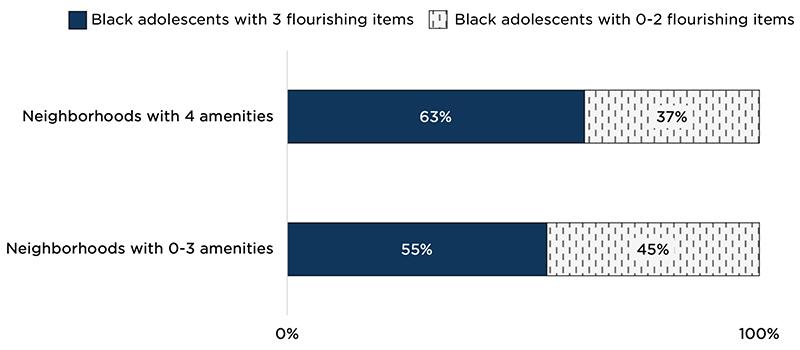Black Adolescents Are More Likely to Flourish in Neighborhoods Featuring Four Key Amenities
Our new analysis of 2020-2021 National Survey of Children’s Health (NSCH)[1] data shows a statistically significant association between flourishing—a condition of mental well-being associated with positive personal and social functioning—and the availability of neighborhood amenities for Black adolescents (ages 12-17). Based on NSCH parental responses, Black adolescents who live in neighborhoods characterized by the presence of sidewalks/walking paths, recreational centers, parks/playgrounds, and libraries/bookmobiles are more likely to exhibit all three NSCH indicators of flourishing (showing interest and curiosity in learning new things, staying calm and in control when faced with a challenge, and working to finish tasks) than Black adolescents who live in neighborhoods that lack one or more of these amenities (63% and 55%, respectively).
Figure: Black Adolescents Are More Likely to Flourish in Neighborhoods Featuring Four Key Amenities
Percentages of Black adolescents flourishing on three items, or two or fewer items, by number of neighborhood amenities

Source: Authors’ analysis of 2020-2021 data from the National Survey of Children’s Health
Our results showing the association between neighborhood conditions and Black adolescent flourishing mirror the findings of other researchers who have examined neighborhood conditions and child flourishing while also controlling for economic hardship, race, biological sex, and child global health. These findings suggest that neighborhoods are important contexts for implementing and evaluating interventions to achieve societal goals for adolescent well-being. The findings also add to the growing body of research on factors such as family connections that have been associated with different measures of adolescent flourishing. The emergent research on child flourishing holds promise for identifying and deepening our understanding of malleable conditions that can maximize youth outcomes.
Despite notable accomplishments in areas like academics, entrepreneurship, and social activism, Black adolescents continue to face systemic barriers to their well-being—both in the larger societal context (e.g., discrimination and disproportionate rates of poverty) and in their local communities (e.g., lack of social services and health-promoting resources). Indeed, our analyses show that, in 2020-2021, more than half (58%) of Black adolescents were reported to exhibit all three indicators of flourishing; however, notably, about one in five (21%) Black adolescents were reported to exhibit only one or none of the three NSCH indicators of flourishing. Researchers, policymakers, and community leaders can help create the conditions that protect Black youth and promote their flourishing across ethnicity, geographic location, socioeconomic background, gender, sexual orientation, disability status, and other dimensions of diversity. Such actions would include identifying and investing in neighborhood amenities and other community protective factors associated with Black adolescents’ mental health and well-being.
Footnote
[1] The NSCH is a national survey, funded and directed by the Health Resources and Services Administration’s Maternal and Child Health Bureau (HRSA MCHB), that provides rich data on multiple intersecting aspects of children’s health and well-being—including physical and mental health, access to and quality of health care, and the child’s family, neighborhood, school, and social contexts. Our primary results are based on a chi-square test using STATA statistical software version 16. Analyses were conducted using weighted estimates for 2020 and 2021. For the relevant indicators, adjustments were made for missing data using listwise deletion. Respondents were those who identified as Black or African American alone and Black with Hispanic or Latino origin.
Suggested citation
Sanders, M., Winston, J., & Rochester, S.E. (2023). Black adolescents are more likely to flourish in neighborhoods featuring four key amenities. Child Trends. https://www.childtrends.org/blog/black-adolescents-are-more-likely-to-flourish-in-neighborhoods-featuring-four-key-amenities
© Copyright 2024 ChildTrendsPrivacy Statement
Newsletter SignupLinkedInThreadsYouTube